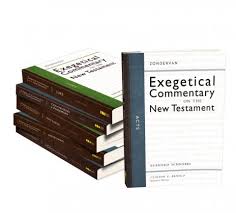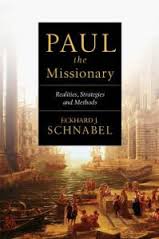The new series, Zondervan Exegetical Commentary on the New Testament (ZECNT), has loads of promise. I haven’t interac ted with enough of the volumes yet to be sure, but my premonition is that it may “take the cake” for general usefulness of a commentary set, both for nonspecialists and specialists, parishioners, pastors, and scholars. All will find something unique and useful in this series. Approached from a different angle, one could argue that this general usefulness is also a liability. In attempting to be useful to broad audiences, the usefulness to more specific audiences (i.e. scholars) is slightly diminished. However, specialists who may or may not have their heads in the clouds need this kind of commentary to remind them about theology in application, and likewise nonspecialists also need healing from the all-too-common pragmatism and anti-intelletualism that is found lurking in our churches. So the ZECNT provides a helpful bridge between the poles of “sola-academia” and “anti-academia.”
ted with enough of the volumes yet to be sure, but my premonition is that it may “take the cake” for general usefulness of a commentary set, both for nonspecialists and specialists, parishioners, pastors, and scholars. All will find something unique and useful in this series. Approached from a different angle, one could argue that this general usefulness is also a liability. In attempting to be useful to broad audiences, the usefulness to more specific audiences (i.e. scholars) is slightly diminished. However, specialists who may or may not have their heads in the clouds need this kind of commentary to remind them about theology in application, and likewise nonspecialists also need healing from the all-too-common pragmatism and anti-intelletualism that is found lurking in our churches. So the ZECNT provides a helpful bridge between the poles of “sola-academia” and “anti-academia.”
I will more specifically review some of the content of this commentary in future posts that engage the Book of Acts itself. For now, however, allow me brief comments on: 1) What makes this author suited to provide a new commentary on Acts? and 2) What justifies a whole new commentary series on the New Testament in the sea of other such useful series’?
1. Why Schnabel Amid a Sea of Options?
 Some may wonder what can be added to the ever-growing corpus of Acts commentaries, especially with recent contributions such as those of Darrel Bock (BECNT) and Craig Keener, and the more dated but equally useful treatments such as those of F. F. Bruce (NICNT) and I. H. Marshall (TCNT). Along with the unique features of the ZECNT series in general (see #2 below), there are a few other reasons why Schnabel has added to the voices of Acts expositors rather than merely creating more din. In particular, we do well to listen to Schnabel on Acts due to his extensive training and skill as a NT scholar, his magisterial research into early church mission, and his international experience.
Some may wonder what can be added to the ever-growing corpus of Acts commentaries, especially with recent contributions such as those of Darrel Bock (BECNT) and Craig Keener, and the more dated but equally useful treatments such as those of F. F. Bruce (NICNT) and I. H. Marshall (TCNT). Along with the unique features of the ZECNT series in general (see #2 below), there are a few other reasons why Schnabel has added to the voices of Acts expositors rather than merely creating more din. In particular, we do well to listen to Schnabel on Acts due to his extensive training and skill as a NT scholar, his magisterial research into early church mission, and his international experience.
Schnabel earned his Ph.D. in NT from the University of Aberdeen (Scotland) and is currently the Mary F. Rockefeller Distinguished Professor of NT Studies at Gordon-Conwell Theological Seminary (Massachusetts). While Schnabel has authored numerous books, he is known among both biblical scholars and missiologists particularly for his two-volume Early Christian Mission (IVP), which is “widely recognized as the most complete and authoritative contemporary study of the first-century Christian missionary movement” (from ivpress.com). He also wrote Paul the Missionary: Realities, Strategies, and Methods, which condenses the former work and bridges between historical, theoretical, and practical side of missions, yielding fruitful reflections and applications for the contemporary missionary enterprise. All this to say, theoreticians and practitioners alike should benefit in a special way from Schnabel’s treatment of Acts, the NT book that documents the incipient stages of Christian mission and church expansion.
Acts is about the Gospel’s unstoppable spread across boundaries of nation and ethnicity. So it helps that Schnabel approaches the text with a multi-lingual and global perspective. He is fluent not only English and German (his native language), but also in six ancient languages and four research languages. Schnabel was involved in mission work in Latin America, Europe, and Asia for more than 20 years before joining the faculty at Trinity Evangelical Divinity School (Illinois). He also has taught biblical/theological studies in China, Belgium, Philippines, Poland, Sri Lanka, Canada, and Germany. All this to say, I don’t expect Schnabel to approach Acts like any run-of-the-mill NT scholar might. We are formed by our experience, and, for better or worse, we bring that experience with us into our reading of the Bible. In this case, for Schnabel, it is for the better.
2. Why the ZECNT Amid a Sea of Options?
The Zondervan Exegetical Commentary on the New Testament series is unique in its format and general usefulness. As for where the ZECNT stands along the spectrum of modern evangelical NT commentaries, it is roughly comparable to such fantastic sets as the New International Commentaries on the New Testament (NICNT), Baker Exegetical Commentaries on the New Testament (BECNT) and Pillar New Testament Commentaries (PNTC). The ZECNT, NICNT, BECNT, and PNTC are all rare birds in that nearly every volume in each set is highly praised. The ZECNT is typically more technical than the Tyndale New Testament Commentaries (TNTC), New American Commentary (NAC), and Expositor’s Bible Commentaries (EBC), though these are generally worthwhile. It is typically less technical than the Word Biblical Commentaries (WBC) and the New International Greek Testament Commentaries (NIGTC), both of which are often indispensible to the student of the NT.
Now that we have placed the ZECNT in its place on the spectrum, I’d like to briefly outline what makes it unique from any other set, and what makes it useful to people of all stripes. Aside from the general excellence among the contributors to this set (all-stars in the field of NT), I see the format, which includes discussion of seven areas for each passage, as its greatest asset. In each commentary in the ZEC, and for each section of the biblical book under consideration, the authors provide discussion of:
- Literary Context. This refers to the function of a passage within the greater context of the book of which it is a part. One of the most important questions for understanding the Bible is, “What comes before and after this passage?” And when you fail to ask this, you will almost invariably misinterpret the text. And any commentary that fails here fails significantly.
- Main Idea. Whenever I read a passage, I try to distill it down to a one- or two-sentence summary. This is often difficult to do, and it helps you wrestle with the meaning like few other exercises. The ZECNT provides such a statement for every passage, which is a wonderful aid in personal study or sermon/lesson preparation. However, this feature, as any feature in a commentary, can be a liability if you simply rely on the study of the commentator in lieu of your own, personal study.
- Translation and Graphical Layout. In this section, the commentator presents his or her own translation of the text in a graphical layout. This is something my graduate school professors would often require us to do in the process of interpreting a passage because doing so raises many syntactical questions (i.e. questions about the flow of a passage and how the parts relate to one another) and helps you come up with tentative answers to those questions. I have seen very few such layouts in commentaries, and I think this feature makes the ZECNT worth its weight in gold!
- Structure and Literary Form. This section seems to offer a brief summary of the structure and thought-flow, including the rational for some of the decisions made in the Graphical Layout section. This will especially help those who get lost in the Graphical Layout!
- Exegetical Outline. Here we have the kind of outline you often find in study Bibles and commentaries. This is particularly helpful when you are trying to explain the flow of the text in the context of teaching or preaching.
- Explanation of the Text. Here we have what is the sum total of many commentaries, the actual verse-by-verse commentary on the text itself. The quality of this section varies based on the author and the care of his research, but all the authors for this set are of high caliber. This section is highly useful for prolonged engagement as well as quick reference. And while some commentaries include convoluted vocabulary and loads of prior knowledge, my understanding is that the ZEC seeks to be clear “even for the nonspecialist.” (Note: While the ZECNT features Greek words, and while familiarity with the Greek language is helpful when reading the commentary, such familiarity is in no way mandatory. There are very few places where you will miss out significantly if you don’t know Greek, and English transliteration and translation is always included.)
- Theology in Application. Most commentaries leave you with #5 and #6. And even those that feature #1-4 often leave out #7. Interpretation is not complete before you answer, “What theological contribution does this text make at the book level, the whole-Bible level, and for the church today?” The ZEC executes this well.
If you are a Christian, I hope you are a student of the Bible. And to that end, I hope you will consider picking up a volume from the ZECNT to enhance your reading of whatever NT book you are currently in.[1] While I am excited to get into Acts and also Schnabel’s commentary, we first need to continue our study of Mark!
A special thanks to Zondervan for a gratis review copy of Acts in exchange for an unbiased review.
Also see Nathaniel Claiborne’s “Seven Reasons You Might Like Zondervan’s Exegetical Commentary on the New Testament.”
[1] To date, the series includes volumes on Matthew (Grant Osbourne), Luke (David Garland), Acts (Eckhard Schnabel), Galations (Thomas Schreiner), Ephesians (Clinton Arnold), Colossians and Philemon (David Pao), 1 & 2 Thessalonians (Gary Shogren), James (Craig Blomberg and Mariam Kamell) and 1-3 John (Karen Jobes, due in February 2014). The set will eventually feature volumes on every NT book.

